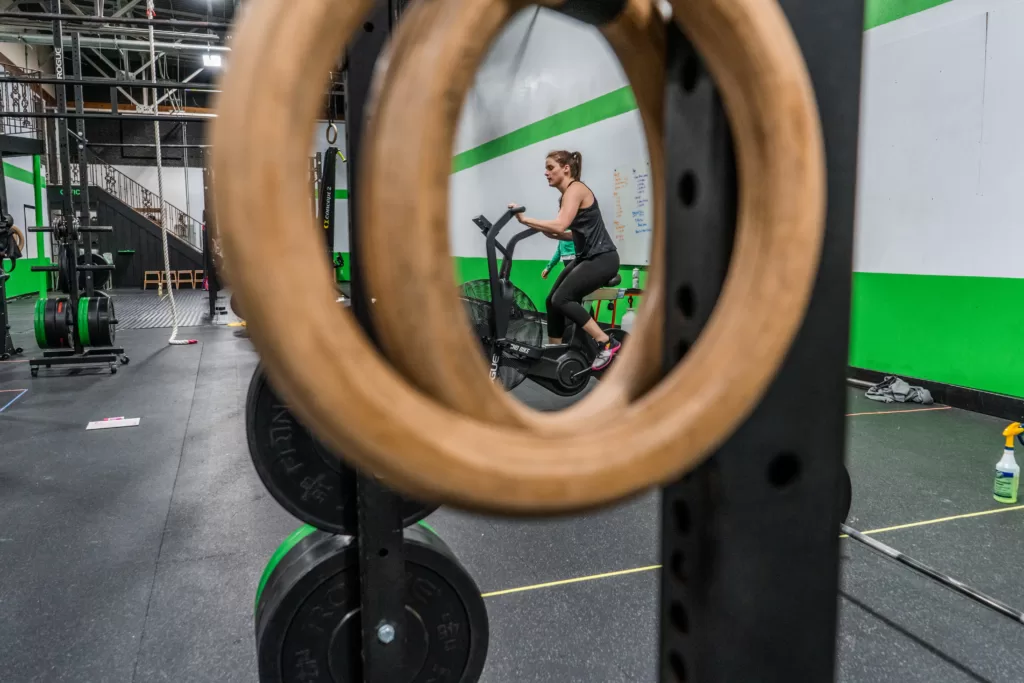Scaling CrossFit Workouts: Tips for Non RX

Are you a beginner looking to take your gym workouts to the next level? Scaling is the key training stimulus that can make all the difference in improving your ability. Whether you’re a seasoned athlete or just starting out, scaling workouts is essential for achieving optimal results and avoiding unnecessary injuries at the gym.
Scaling in the gym allows you to tailor each workout to your specific ability level, ensuring that you’re always challenged without pushing yourself too far. By adjusting the barbell training stimulus and loading, scaling enables you to progress at your own pace while still reaping the benefits of CrossFit power.
We’ll explore how scaling in the gym helps prevent injuries and promotes individual growth within the sport of training. So get ready to discover how scaling can revolutionize your approach to CrossFit and unlock your true potential with the training stimulus of a barbell.
Let’s jump right in!
Understanding the Concept of Scaling in CrossFit Workouts
Scaling in CrossFit workouts is a crucial concept that allows athletes at the gym to adapt their training to their individual ability and goals. It involves making modifications to the prescribed workout, ensuring that it remains challenging yet manageable for each athlete. Let’s dive deeper into the definition, purpose, and examples of scaling in terms of CrossFit workouts and the role of coaches in this process.
Definition and Purpose of Scaling in CrossFit
Scaling refers to adjusting various aspects of a workout, such as load, repetitions, distance, or intensity, to match an athlete’s skill level or physical capacity. The primary purpose of scaling is to ensure inclusivity within the gym culture by making workouts accessible to individuals with different fitness levels. It allows beginners and experienced athletes alike to participate in the same class while tailoring the exercises to meet their unique needs and provide the necessary training stimulus.
How Scaling Helps Adapt Workouts to Individual Abilities and Goals
Scaling plays a vital role in helping athletes and clients progress safely without sacrificing intensity. By modifying certain elements of a workout, individuals can maintain proper form, reduce injury risk, and gradually build strength and endurance over time. Whether someone is recovering from an injury or simply starting their fitness journey, scaling enables them to challenge themselves effectively while avoiding overwhelming physical demands. This training stimulus is essential for members to achieve their goals.
Examples of Common Modifications Used for Scaling Workouts
- Reducing Weight: Athletes can decrease the weight lifted during exercises like squats or deadlifts until they develop sufficient strength.
- Adjusting Repetitions: Lowering the number of repetitions allows athletes who are new to CrossFit or working on specific skills to maintain proper form throughout.
- Changing Movements: Substituting complex movements with simpler variations helps beginners learn proper technique before progressing.
- Altering Intensity: Adjusting intensity levels by reducing speed or incorporating rest intervals ensures that athletes work within their current fitness capabilities.
The Role of Coaches in Guiding Athletes through the Scaling Process
Coaches in CrossFit gyms are instrumental in guiding their clients through the scaling process. They possess the knowledge and expertise to assess individual abilities, provide appropriate modifications, and ensure their clients understand how to scale effectively. Coaches also play a crucial role in monitoring their clients’ progress, adjusting scaling options as needed, and encouraging them to push their limits while maintaining safety.
Tips and Strategies for Scaling Classic CrossFit Workouts: Murph
Understanding the Murph Workout
Murph is a classic CrossFit workout that pays tribute to Navy Lieutenant Michael P. Murphy, who lost his life in Afghanistan. It consists of a one-mile run, 100 pull-ups, 200 push-ups, 300 air squats, and another one-mile run. The intensity level of Murph can be quite challenging even for experienced athletes. This training is popular among CrossFit members and clients.
Reducing Volume and Modifying Movements
Scaling Murph allows training members and clients to adjust the workout based on their fitness level or limitations. Here are some options for reducing volume or modifying movements.
- If running long distances isn’t your strong suit, consider shortening each mile to half a mile or even quarter miles to accommodate all members.
- If members struggle with strict pull-ups, they can use assistance bands to provide support during the movement. Loop an assistance band around the bar and perform the pull-ups with the help of the band.
- Perform push-up variations to accommodate all members. If traditional push-ups are too difficult for certain members, they can try doing them from their knees or against an elevated surface like a box or bench.
- If performing 300 air squats seems overwhelming for our members, they can switch to box squats where they sit back onto a box before standing up again.
Pacing and Rep Partitioning
To effectively tackle scaled Murph workouts, it’s essential for members to focus on pacing and partitioning reps.
- Break up exercises into smaller sets: Instead of attempting all 100 pull-ups or 200 push-ups at once, divide them into manageable sets. For example, aim for five sets of twenty repetitions each.
- Take strategic rest breaks: Listen to your body and rest when needed between sets. This approach helps maintain consistent effort throughout the workout rather than burning out quickly.
- Pace yourself during runs: When scaling Murph, remember that it’s not just about finishing the workout quickly. Find a pace that allows you to conserve energy for the entire duration.
Maintaining Proper Form and Technique
While scaling Murph, it’s crucial to prioritize maintaining proper form and technique:
- Focus on quality over quantity: Don’t sacrifice form just to complete more reps. Performing exercises with correct technique helps prevent injuries and ensures maximum benefit.
- Engage your core: Keep your core tight during pull-ups, push-ups, and air squats to maintain stability and protect your lower back.
- Use full range of motion: Ensure you’re going through the full range of motion for each exercise. This means fully extending your arms at the bottom of push-ups and reaching full depth in air squats.
Scaling CrossFit workouts like Murph allows individuals of all fitness levels to participate while still challenging themselves. By adjusting volume, modifying movements, pacing strategically, and focusing on maintaining proper form, anyone can experience the intensity and sense of accomplishment that Murph offers. So grab your gear, lace up those shoes, and get ready to conquer this iconic CrossFit workout!

Tips and Strategies for Scaling Classic CrossFit Workouts: Fran
Overview of the Fran workout structure and high-intensity nature
Fran is one of the most iconic and challenging workouts in the CrossFit community. It consists of performing 21-15-9 repetitions of thrusters and pull-ups as fast as possible. This combination of movements targets multiple muscle groups while pushing your cardiovascular endurance to the limit. Scaling Fran allows individuals to participate regardless of their fitness level, ensuring a safe and effective workout experience.
Suggestions for adjusting weight, repetitions, or movement variations when scaling Fran
Scaling Fran can be done by modifying the weight, repetitions, or movement variations involved. Here are some recommendations to make it more accessible:
- Reducing weight: If you’re new to CrossFit or still building strength, consider using lighter weights for thrusters. This modification allows you to focus on maintaining proper form while still challenging yourself.
- Adjusting repetitions: For those who find the prescribed 21-15-9 rep scheme too demanding, reducing the number of reps can make it more manageable. Start with a higher rep count like 15-12-9 or even 12-9-6 until you feel comfortable progressing towards the full workout.
- Modifying movements: If pull-ups pose a challenge, there are alternative movements that target similar muscle groups without requiring strict pull-up technique. Options include ring rows, assisted pull-ups using resistance bands, or even jumping pull-ups.
Emphasizing the importance of maintaining intensity even with scaled versions
Scaling Fran doesn’t mean sacrificing intensity; it’s crucial to maintain a high level of effort throughout your workout. Here’s how you can ensure that:
- Time cap: Set a time cap for completing each round or the entire workout to keep yourself motivated and accountable. Push yourself to finish within that time frame while maintaining good form.
- Focus on speed: Even with scaled versions, aim to perform each rep as quickly as possible without compromising technique. This intensity will help you build strength and improve your overall fitness.
- Mental toughness: Scaling workouts can sometimes be demotivating, but it’s essential to stay mentally strong. Remind yourself that every rep counts, regardless of the modifications you make.
Recommendations on rest periods between sets during scaled Fran workouts
Rest periods play a crucial role in maintaining intensity while allowing for recovery during scaled Fran workouts. Here are some guidelines:
- Listen to your body: Pay attention to how your body feels during the workout. If you need a short break to catch your breath or regain composure, take it. However, avoid resting for too long as it may disrupt the flow of the workout.
- Strategic breaks: Plan your rest periods strategically by breaking up sets into manageable chunks. For example, if you’re performing 15 thrusters, consider doing 5 reps at a time with short rests in between.
- Active recovery: Instead of completely stopping during rest periods, engage in active recovery exercises such as light jogging or dynamic stretching.
Tips and Strategies for Scaling Classic CrossFit Workouts: Cindy
Cindy is a classic CrossFit workout that focuses on bodyweight movements and high repetition counts. It consists of three exercises: pull-ups, push-ups, and air squats. The goal is to complete as many rounds as possible in 20 minutes. While this workout can be challenging for beginners or those with physical limitations, there are ways to scale it down to ensure an effective and safe workout.
Modifying movements or reducing rounds when scaling Cindy
Scaling Cindy is all about finding the right modifications that suit your fitness level. If you’re unable to perform strict pull-ups, you can try using resistance bands or opting for ring rows instead. For push-ups, you can do them from your knees or against an elevated surface like a bench. Air squats can be modified by reducing the depth or using a chair for support if needed.
Reducing the number of rounds is another way to scale Cindy. Instead of aiming for as many rounds as possible in 20 minutes, set a specific target based on your capabilities. This allows you to focus on maintaining proper form and intensity throughout each round without feeling overwhelmed.
Strategies to maintain consistent pacing throughout a scaled Cindy workout
Consistency is key when scaling any CrossFit workout, including Cindy. One strategy is to break down each round into manageable sets. For example, instead of doing all the repetitions in one go, divide them into smaller sets with short rest intervals in between.
Another approach is to establish a steady rhythm from the beginning and stick with it throughout the entire workout. This helps prevent burnout early on and allows you to maintain a more sustainable pace over time.
Suggestions on incorporating appropriate rest intervals during a scaled Cindy session
Rest intervals play an essential role in any CrossFit workout, especially when scaling down the intensity. It’s crucial to listen to your body and take breaks when needed to avoid overexertion or injury.
Here are some suggestions for incorporating rest intervals during a scaled Cindy session:
- Perform each exercise in sets, taking short breaks between sets.
- Set a specific work-to-rest ratio, such as 1:1 or 2:1, depending on your fitness level.
- Use a timer or stopwatch to track your rest periods and ensure they’re consistent.
Remember, the goal is not to rush through the workout but rather maintain a steady pace while allowing yourself enough time to recover between sets.
By modifying movements, reducing rounds, maintaining consistent pacing, and incorporating appropriate rest intervals, you can effectively scale down the classic CrossFit workout Cindy. This allows individuals of all fitness levels to reap the benefits of this challenging routine without compromising safety or intensity.
So next time you tackle Cindy, embrace these strategies and push yourself within your limits for an empowering and rewarding workout experience.
Now go crush those cleans!
Tips and Strategies for Scaling Classic CrossFit Workouts: Diane
Understanding Diane’s Focus
Diane is a classic CrossFit workout that places heavy emphasis on deadlifts and handstand push-ups. The goal of this workout is to test your strength, stamina, and technique in these two movements. It’s important to understand the main focus of Diane before scaling it.
Adjusting Weights and Movements
When scaling Diane, there are several options to consider based on your fitness level and capabilities. Here are some tips for adjusting weights or using alternative movements:
- Decrease the weight on the deadlifts: If the prescribed weight feels too heavy, reduce it to a more manageable load. This will allow you to maintain proper form while still challenging yourself.
- Modify handstand push-ups: If you’re not yet able to perform strict handstand push-ups, there are alternative movements you can try. Consider using dumbbells or kettlebells for overhead presses or performing pike push-ups against a wall.
- Reduce the number of repetitions: If completing the full rep scheme seems overwhelming, decrease the number of reps for each movement. This will help you build strength and improve your technique gradually.
Ensuring Safety While Scaling
Safety should always be a top priority when scaling any CrossFit workout. Here are some techniques to ensure safety while performing scaled versions of Diane:
- Focus on maintaining proper form: Pay close attention to your body positioning during deadlifts and handstand push-ups. Keep your back straight, engage your core, and avoid rounding your shoulders.
- Use appropriate equipment: Make sure you have access to suitable equipment such as mats for handstand push-ups or lifting belts for added support during deadlifts.
- Listen to your body: If something doesn’t feel right or if you experience pain during the workout, stop immediately and consult with a coach or healthcare professional.
Warm-up Exercises and Mobility Drills
Proper warm-up exercises and mobility drills are essential for preparing your body for the demands of a scaled Diane workout. Here are some recommendations:
- Dynamic stretching: Perform exercises like arm circles, leg swings, and torso twists to increase blood flow and loosen up your muscles.
- Foam rolling: Use a foam roller to target specific areas such as your hamstrings, glutes, and upper back. This will help alleviate any tightness or knots in those areas.
- Activation exercises: Include movements that activate the muscles you’ll be using during Diane, such as glute bridges, scapular retractions, or push-up variations.
Remember to consult with a coach or trainer for personalized warm-up recommendations based on your fitness level and specific needs.
Scaling classic CrossFit workouts like Diane can be challenging but rewarding. By adjusting weights, using alternative movements, ensuring safety precautions, and incorporating proper warm-up exercises, you can make progress towards your fitness goals while avoiding injury. Stay consistent in your training and don’t hesitate to seek guidance from experienced coaches along the way.
Tips and Strategies for Scaling Classic CrossFit Workouts: Helen
What is Helen?
Helen is a classic CrossFit workout that combines running, kettlebell swings, and pull-ups. It’s a challenging WOD (Workout of the Day) that tests your endurance, strength, and overall fitness. Scaling Helen allows individuals of all fitness levels to participate and still get an effective workout.
Modifying Distances, Kettlebell Weights, or Pull-Up Variations
When scaling Helen, you have several options to modify the workout based on your abilities. Here are some suggestions:
- Distance: If running long distances isn’t feasible for you yet, reduce the distance but maintain intensity. For example:
- Instead of 400 meters, run 200 meters.
- Modify it further by doing shuttle runs or rowing instead.
- Kettlebell Weight: Adjusting the kettlebell weight can make the workout more manageable while still challenging your muscles. Consider these modifications:
- Use a lighter kettlebell than prescribed.
- If necessary, substitute kettlebell swings with dumbbell or medicine ball swings.
- Pull-Up Variations: Pull-ups can be difficult for beginners or those lacking upper body strength. Here are some alternatives:
- Perform banded pull-ups using resistance bands for assistance.
- Substitute regular pull-ups with jumping pull-ups or ring rows.
Pacing Strategies to Maintain Intensity
Maintaining intensity during a scaled Helen session is crucial to get the most out of your workout. Here are some pacing strategies to consider:
- Break Up Reps: Divide each round into smaller sets to manage fatigue better.
- For example, instead of doing 21 unbroken kettlebell swings or pull-ups, break them up into sets of 7-7-7.
- Manage Running Pace: Find a sustainable running pace that allows you to recover slightly between rounds.
- Avoid going all-out on the first run, which could leave you exhausted for the rest of the workout.
- Focus on Transitions: Minimize transition times between exercises to maintain momentum and intensity.
- Quickly move from the kettlebell swings to pull-ups or vice versa, keeping rest periods short.
Importance of Warm-Up and Cool-Down Routines
When scaling Helen, it’s crucial not to neglect your warm-up and cool-down routines. Here’s why:
- Warm-Up: A proper warm-up prepares your body for the workout, reducing the risk of injury and improving performance.
- Perform dynamic stretches, such as leg swings or arm circles.
- Activate key muscle groups with exercises like air squats or scapular retractions.
- Cool-Down: Cooling down helps your body recover and reduces post-workout soreness.
- Incorporate static stretching to improve flexibility and reduce muscle tightness.
- Use foam rollers or massage tools to release tension in specific areas.
Remember, scaling workouts is about finding a balance between challenging yourself and maintaining good form throughout each movement.
Making Informed Decisions: Choosing Between Scaled and RX’d Workouts in CrossFit
Factors to Consider
There are several factors to consider before deciding between scaled and RX’d options. Understanding these factors will help you make informed decisions that align with your personal goals, abilities, and limitations.
Personal Goals, Abilities, and Limitations
One of the most important aspects to consider when choosing between scaled and RX’d workouts is understanding your own goals, abilities, and limitations. Ask yourself what you want to achieve through your CrossFit journey. Are you aiming for improved strength? Increased endurance? Or maybe you simply want to challenge yourself physically and mentally?
Once you have a clear understanding of your goals, assess your current abilities and limitations. Be honest with yourself about what movements or weights may be too challenging or risky for you at this stage. It’s crucial to prioritize safety over ego when making these decisions.
Benefits of Challenging Yourself
While opting for scaled workouts can be a great way to gradually build strength and skill, there are undeniable benefits to challenging yourself with RX’d workouts as well. Pushing beyond your comfort zone can lead to significant improvements in both physical fitness and mental resilience.
By attempting RX’d workouts, you expose yourself to movements and weights that may initially seem daunting but can ultimately help you progress faster. However, always remember that safety should never be compromised in pursuit of an RX’d workout. Communicate openly with your coaches about any concerns or doubts you may have.
Communication with Coaches
The role of communication with coaches cannot be emphasized enough. Your coaches are there not only as instructors but also as mentors who understand the intricacies of each workout.
Reach out to them for guidance on whether an RX’d workout is suitable for you based on your current capabilities. They can provide valuable insights into modifications or substitutions that will keep you challenged while minimizing the risk of injury. Remember, coaches are there to support and guide you on your fitness journey.
Mastering the Art of Scaling CrossFit Workouts
Scaling crossfit workouts is an essential skill for anyone looking to maximize their fitness journey. By understanding the concept of scaling and implementing effective strategies, you can tailor classic CrossFit workouts to your individual abilities and goals. Whether you’re tackling Murph, Fran, Cindy, Diane, or Helen, these tips will help you scale intelligently and achieve optimal results.
Firstly, it’s crucial to grasp the concept of scaling in CrossFit workouts. Scaling involves modifying the workout’s intensity, volume, and movements to suit your current fitness level. It allows you to maintain proper form while challenging yourself appropriately. By scaling smartly, you can avoid injury and steadily progress towards more advanced movements.
Fran, Cindy, Diane, or Helen, there are various tips and strategies that can guide your scaling decisions. For instance:
- In Murph: Break up the repetitions into manageable sets and adjust the distances if needed.
- In Fran: Modify the weight of the thrusters or use a band for pull-ups until you build strength.
- In Cindy: Reduce the number of rounds or modify exercises like push-ups with knee push-ups.
- In Diane: Adjust the weight of deadlifts and handstand push-ups by using lighter loads or doing pike push-ups instead.
- In Helen: Shorten the distance for runs or modify kettlebell swings with a lighter weight.
To make informed decisions between scaled and RX’d workouts in CrossFit, consider factors such as your current fitness level, any injuries or limitations you may have, and your overall goals. Remember that scaling is not a sign of weakness but rather a way to ensure safety while still challenging yourself effectively.
In conclusion, mastering the art of scaling in CrossFit workouts empowers you to optimize your training without compromising safety or progress. By understanding how to scale classic workouts like Murph, Fran, Cindy, Diane, and Helen, you can tailor them to your unique abilities and steadily push yourself towards higher levels of fitness. Embrace scaling as a valuable tool in your CrossFit journey and unlock your full potential.
Frequently Asked Questions (FAQs)
Q: Can I still get results if I scale CrossFit workouts?
A: Absolutely! Scaling allows you to maintain proper form and intensity while gradually building strength and endurance. It ensures that you’re working at the appropriate level for your current fitness capabilities.
Q: How do I know when to scale a workout?
A: You should consider scaling a workout if the prescribed weights or movements are beyond your current abilities or if you have any physical limitations or injuries. Listen to your body and make adjustments accordingly.
Q: Is it better to scale or strive for RX’d workouts?
A: The decision between scaled and RX’d workouts depends on your individual circumstances. It’s important to prioritize safety and proper form over pushing yourself too far too soon. Gradually increasing the challenge will yield better long-term results.
Q: Will scaling hinder my progress in CrossFit?
A: Scaling is an integral part of progress in CrossFit. By tailoring workouts to suit your abilities, you can build a strong foundation while minimizing the risk of injury. As you improve, you can gradually increase the difficulty level.
Q: How can I track my progress when scaling workouts?
A: Keep a record of the modifications made during scaled workouts, such as lighter weights used or modified movements performed. This way, you can monitor improvements over time and adjust scaling accordingly.
These FAQs provide answers to common questions that may influence purchase decisions related to scaling crossfit workouts.

Dave Carter
Dave serves as the head writer and chief content curator for CrossFitopedia.com, the premier destination for CrossFit enthusiasts seeking to enhance their fitness journeys.






